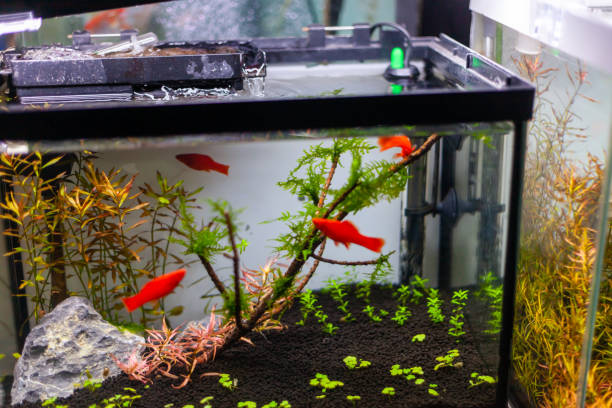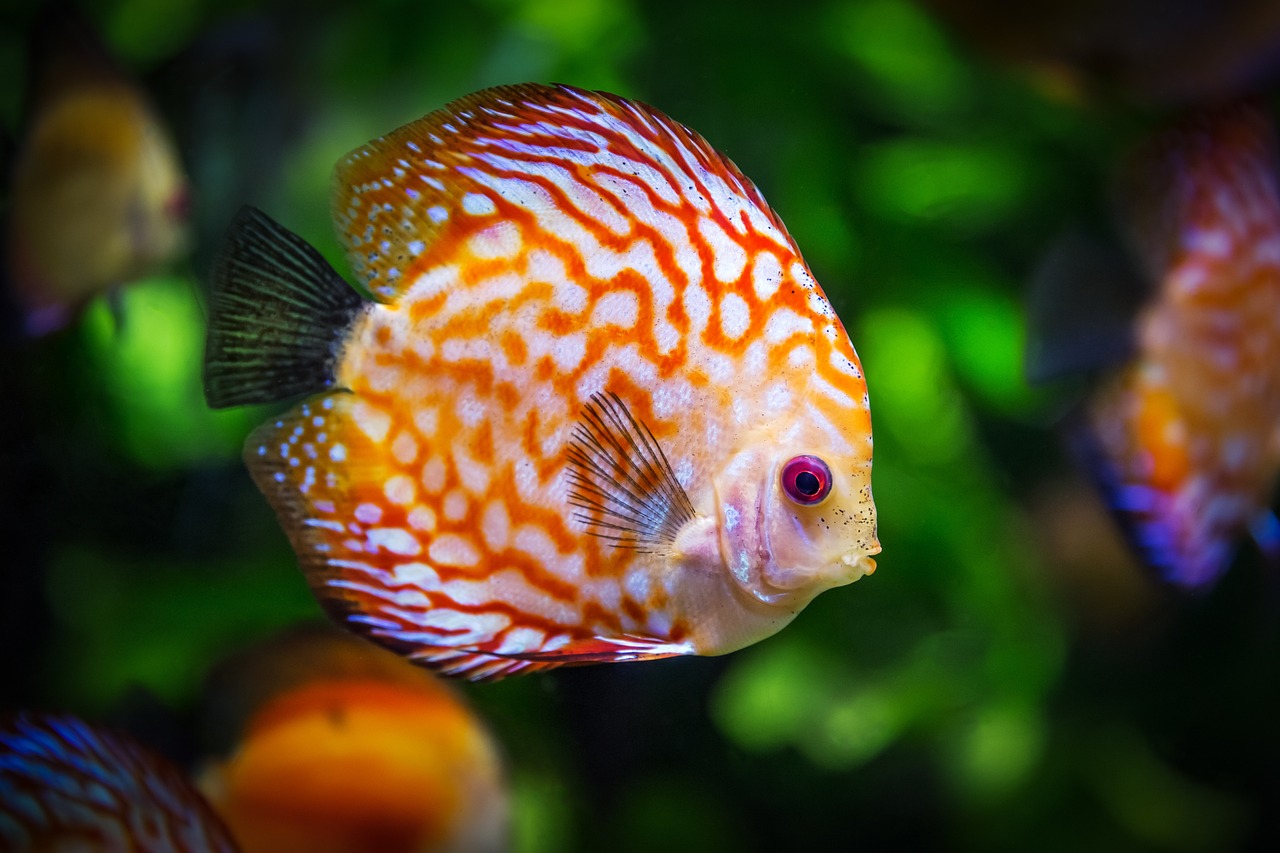Owning an aquarium brings joy, but it also requires vigilant care to ensure your fish stay healthy. Preventing and treating common fish diseases is essential for maintaining a thriving aquatic environment. Regular observation of your fish’s behavior and appearance is crucial. Clean water, proper filtration, and a balanced diet play key roles in disease prevention.
Avoid overfeeding, as it can lead to water contamination and stress-related illnesses. Quarantine new fish before introducing them to the main tank to prevent the spread of potential diseases. Familiarize yourself with the symptoms of common fish ailments, such as fin rot, ich, and dropsy, to detect any issues early. Properly identifying the disease is crucial for selecting the right treatment.

Simple treatments like salt baths and temperature adjustments can help alleviate mild cases, while antibiotics and antifungal medications are necessary for more severe infections. Regular water testing and maintaining optimal water parameters are vital for preventing the onset of diseases. By following these simple guidelines, you can ensure a healthy and vibrant aquatic ecosystem for your beloved fish.
Maintaining Water Quality: Key to Healthy Fish
Maintaining water quality is paramount for ensuring the well-being of your aquarium inhabitants. Regular water testing for pH levels, ammonia, nitrites, and nitrates is crucial to monitor the overall health of the aquatic environment. Keeping the water clean through regular partial water changes helps remove accumulated toxins and waste, promoting a healthier ecosystem.
Avoid overfeeding your fish as uneaten food can decompose, leading to an increase in ammonia levels. Installing an efficient filtration system is essential to remove debris, excess food, and waste products, thereby maintaining a stable and clean aquatic environment. Adequate oxygen levels are necessary for the survival of your fish; consider using aeration devices or air stones to enhance oxygenation. Controlling algae growth is vital, as excessive algae can deplete oxygen levels and create an unappealing aesthetic. Introducing algae-eating fish or manually removing algae can help manage its growth. Protecting the aquarium from direct sunlight prevents excessive algae growth and the occurrence of rapid temperature fluctuations.

Maintaining a consistent water temperature suitable for the specific fish species in your aquarium is vital for their overall health and well-being. Regular maintenance of equipment such as filters and heaters ensures their proper functioning, contributing to a stable and healthy aquatic environment. By prioritizing these practices, you can create an optimal environment for your fish, promoting their health and longevity.
Identifying Common Fish Ailments: Early Detection Tips
Identifying common fish ailments at their initial stages is vital for prompt treatment and prevention of further complications. Regular observation of your fish’s behavior, such as reduced appetite, abnormal swimming patterns, or lethargy, can be early indicators of health issues. Physical examination of the fish for visible symptoms like unusual spots, discoloration, or torn fins is crucial for identifying common ailments like ich, fin rot, or fungal infections.
Pay attention to any changes in breathing patterns, such as rapid gill movement or gasping at the water’s surface, which can signify respiratory distress or poor water quality. Keeping a watchful eye for any abnormal growths or lesions on the fish’s body can indicate more severe health concerns, such as tumors or parasites. Monitoring the overall condition of the aquarium, including the presence of excess debris, algae overgrowth, or unusual odor, is essential for identifying potential sources of disease outbreaks.
Recognizing behavioral changes among fish in the same tank, such as increased aggression or social isolation, may suggest underlying health issues or territorial disputes. Maintaining a record of your fish’s health history, including any past diseases or treatments, can aid in identifying recurring ailments or susceptibility to specific health problems.
Seeking professional guidance from a veterinarian or a knowledgeable aquatic specialist can provide valuable insights and help identify and treat complex fish health issues effectively. By being attentive to these early detection tips, you can ensure the timely intervention and well-being of your aquatic companions
Quarantine Practices: Shielding Your Main Tank
mplementing effective quarantine practices is crucial to safeguard the health of your main aquarium inhabitants. Quarantining new fish before introducing them to the main tank helps prevent the spread of potential diseases and parasites. A separate quarantine tank should be set up with its filtration system and basic equipment, ensuring it mirrors the main tank’s water parameters.
Treating the quarantined fish with preventive medications, such as antiparasitic or antibacterial treatments, can help eliminate any potential pathogens before introducing them to the main tank. Maintaining optimal water quality in the quarantine tank through regular water changes and filtration system maintenance is critical for the well-being of the isolated fish.

Ensuring that the quarantine tank is located in a quiet area with minimal disturbances helps reduce stress on the quarantined fish, allowing them to acclimate and recover without unnecessary pressure. Quarantine duration may vary depending on the species and their susceptibility to diseases; however, a general quarantine period of two to four weeks is advisable.
Avoid using any decorative items or substrates from the main tank in the quarantine tank, as they may carry potential pathogens or contaminants that can harm the isolated fish. After the quarantine period, closely monitor the quarantined fish for any signs of illness before introducing them to the main tank, ensuring the safety of the existing aquatic community. By adhering to these quarantine practices, you can protect the overall health and stability of your main aquarium ecosystem
Simple Remedies: Salt Baths and Temperature Adjustments
Employing simple remedies like salt baths and temperature adjustments can effectively aid in treating mild fish health issues. Salt baths, when administered correctly, can help alleviate external parasites, bacterial infections, and fungal growth on the fish’s body. Preparing a salt bath solution with non-iodized salt and treating the affected fish for a short duration can promote healing and reduce stress.
Be cautious not to expose the fish to salt baths for extended periods, as prolonged exposure can harm their delicate skin and internal organs. Temperature adjustments can also play a significant role in alleviating certain fish ailments. Raising the water temperature slightly can help boost the fish’s immune system and accelerate the healing process. However, be mindful not to increase the temperature abruptly, as it may lead to additional stress and adversely affect the fish’s overall health.
Lowering the water temperature can be beneficial for treating certain parasitic infections, as cooler water temperatures can impede the parasites’ life cycle and reduce their population. Gradual temperature adjustments should be executed to prevent any sudden temperature shocks that may harm the fish. Monitoring the fish closely during these treatments is essential to ensure they exhibit positive responses without any adverse reactions or side effects.
It’s crucial to conduct thorough research and consult with aquatic specialists or experienced hobbyists before implementing these simple remedies, as improper administration can worsen the fish’s condition. By employing these simple yet effective remedies, you can aid in the recovery and well-being of your cherished aquatic companions
Essential Medications: Antibiotics and Antifungal Treatments
Employing essential medications like antibiotics and antifungal treatments is crucial for effectively addressing severe fish health issues. Antibiotics are instrumental in treating bacterial infections, including fin rot, columnaris, and bacterial septicemia, among others. Administering antibiotics as directed by a veterinarian or aquatic specialist can help eradicate harmful bacteria without negatively impacting the aquarium’s beneficial bacteria colony.
It’s vital to use antibiotics sparingly and strictly follow the recommended dosage to avoid the development of antibiotic-resistant strains of bacteria. Antifungal treatments are effective in combating fungal infections, such as cotton wool disease and fungal gill infections. Applying antifungal medications to the affected fish or directly into the aquarium water can help eliminate fungal growth and prevent its spread to other aquatic inhabitants.
However, careful consideration must be given to the type of antifungal treatment used, as some medications may harm certain fish species or disrupt the aquarium’s biological balance. Before administering any medications, it’s essential to accurately diagnose the fish’s ailment and consult with a qualified aquatic expert to determine the most suitable treatment approach. Regular monitoring of the treated fish during the medication period is crucial to ensure their well-being and response to the treatment. Discontinuing medication once the fish show signs of recovery is important to prevent any adverse effects from prolonged exposure.
Additionally, conducting partial water changes and utilizing activated carbon filtration can help remove any residual medication from the aquarium, maintaining a healthy aquatic environment. By understanding the importance of these essential medications and their proper application, you can effectively combat severe fish health issues and promote the long-term well-being of your aquatic community.
Conclusion
In conclusion, proactive measures and timely interventions are pivotal in maintaining a healthy and thriving aquarium environment. By prioritizing water quality maintenance, regular observation, and effective quarantine practices, you can significantly reduce the risk of disease outbreaks and promote the well-being of your fish. Being vigilant about identifying common fish ailments early on enables swift and appropriate treatment, minimizing the impact on the overall aquatic ecosystem.
Implementing simple remedies such as salt baths and temperature adjustments can provide immediate relief for mild health issues, while the careful administration of essential medications like antibiotics and antifungal treatments is crucial for combating severe infections. It’s essential to seek guidance from experienced aquarists or aquatic specialists and conduct thorough research before administering any medications, ensuring the safety and well-being of your fish.
Regular monitoring of the aquarium’s water parameters, equipment, and the overall health of the fish is key to maintaining a stable and thriving aquatic environment. Educating yourself about different fish species’ specific requirements and behavioral patterns can aid in preventing stress-related illnesses and promoting a harmonious aquatic community.
Emphasizing a holistic approach to fish care, including proper nutrition, adequate space, and environmental enrichment, fosters a resilient and vibrant aquatic ecosystem. By incorporating these preventive measures and treatment strategies into your aquarium maintenance routine, you can create a healthy and sustainable habitat for your beloved fish to thrive and flourish for years to come.





